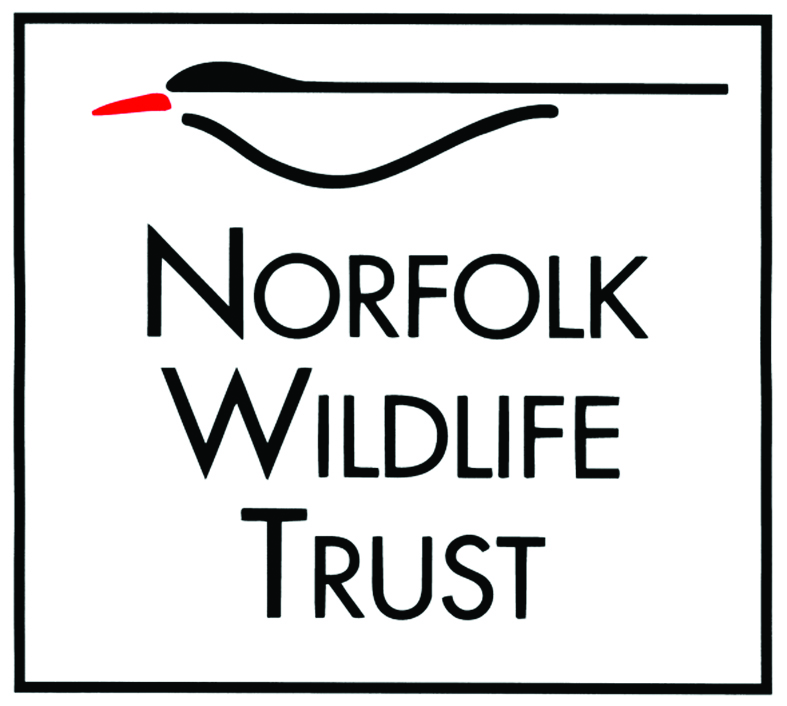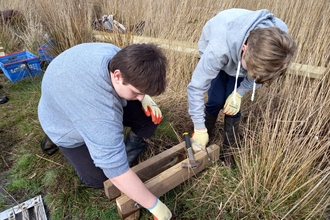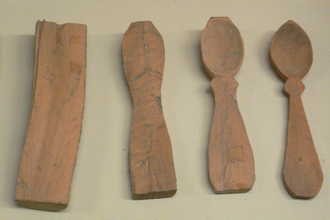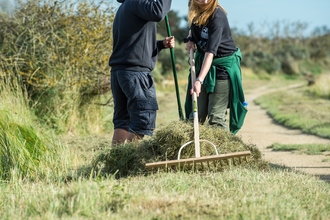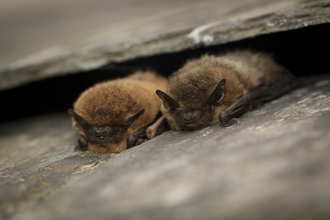Please note the cattle on this site use no fence collars. Find out more.
Aerial image over Sweet Briar Marshes (credit: Shaun Lawson)
Visitors at Sweet Briar Marshes (credit: Denzil Dean)
Person standing under an oak tree at Sweet Briar (credit: Denzil Dean)
Song thrush at Sweet Briar Marshes (credit: Caroline Spinks)
British White cattle (credit: Sarah Wilde)
Sweet Briar Marshes
Location
There are two entrances to the reserve from Marriott's Way - look out for signs. The east entrance is close to Sloughbottom Park (what3words: will.rang.latter). The west entrance is close to Hellesdon Road (what3words: frosted.atom.remedy)
Know before you go
Dogs
Dogs on short leads. Visitors with dogs must stay on the paths and keep dogs on a two metre lead to avoid disturbance to livestock and wildlife. Some areas of the site may have a temporary no dog policy in place - please observe signage on site.
When to visit
Opening times
Dawn till dusk, every day, all year round.Best time to visit
All year round.About the reserve
The reserve sits by the River Wensum and forms a ribbon of green through an otherwise urban environment. It is a fabulous mosaic of wetland habitats, including grassland, tall-herb fen, veteran hedgerows and scrub. This wetland is important for declining plant species such as early marsh orchid, devil's-bit scabious and ragged robin.
Sweet Briar Marshes is wonderful for wildlife throughout the year. In winter, spot noisy flocks of small birds such as long-tailed tits searching for seeds in the trees. Listen out in spring for the rambling notes of sedge warbler and loud repetitive call of song thrush. Come summer, the meadows brim with flowers, dragonflies and feeding butterflies such as red admiral, meadow brown and skippers.
NWT's vision is to protect and enhance the site for the city, its wildlife and residents. It is also our ambition to ensure this wonderful green space thrives as a hub for both the education and the wellbeing of the wider community through appreciation of the natural world.
History:
This uniquely wild place and its sensitive ecology – including a Site of Special Scientific Interest (SSSI) – was in danger of being lost forever. We launched a public appeal in 2022 to save it and thanks to enormous support from funders, the local community and our loyal supporters, were able to take the land into our ownership later that year.
Long-term NWT supporters, Aviva, generously pledged up to £300,000 in match funding, helping to complete the public appeal to purchase the site just four months after it was launched, making this the fastest appeal success in our history. Aviva continue to support as our project partner at Sweet Briar Marshes, both financially and through staff volunteering.
Read more about the Discovery Phase and our engagement work
Find out about our future plans for Sweet Briar Marshes
Getting to Sweet Briar Marshes from nearby car parks:
Sloughbottom Park car park: Head through the park, past the pavilion, until you reach Marriott’s Way. Turn right onto Marriot's Way and walk along until you reach the east entrance to the reserve (accessed via Mile Cross Marsh, just off Marriott’s Way). It is approximately 400 metres from the car park to the reserve.
Hellesdon Road Riverside Walk car park: From the car park turn right onto Hellesdon Road, at the junction with Marlpit Lane, bear right along Hellesdon Road until you meet the Mariott’s Way then turn right. It is approximately 600 metres from the car park to the reserve.
Alternatively leave the car park towards the river Wensum, turn left along the river bank towards the Marriott’s way, turn right onto the Marriott’s way until you reach the reserve. Please note: The riverside walk at this point is a natural route that is subject to flooding and the junction with the Marriott’s Way has steep steps/bank. It is approximately 400 metres from the car park to the reserve.
Hellesdon Mill car park: Leave the car park and turn right onto Hellesdon Mill Lane, turn right at the junction with Hellesdon Road, head over the river bridge, turn left onto the Marriott’s Way to the reserve entrance. It is approximately 600 metres from the car park to the reserve.
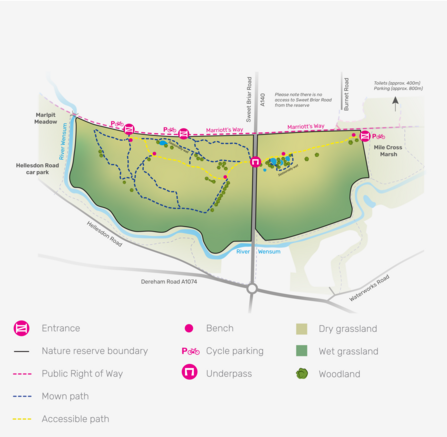
Seasonal highlights
Spring
Plants: marsh marigold, yellow flag iris.
Birds: reed bunting, whitethroat, willow warbler.
Amphibians: common toad
Summer
Plants: bogbean, early marsh orchid.
Birds: swallow, swift, blackcap.
Insects: banded demoiselle, meadow brown butterfly.
Mammals: water vole.
Reptiles: grass snake, common lizard
Autumn
Plants: purple loosestrife.
Birds: siskin, lesser redpoll, green woodpecker
Winter
Birds: kingfisher, fieldfare, redwing
